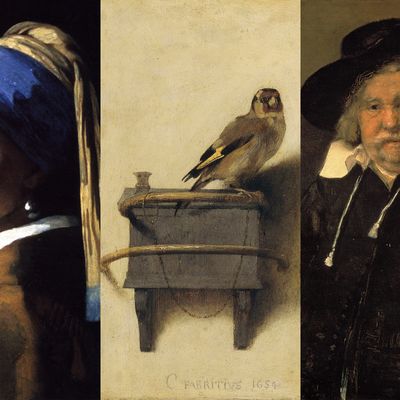
If you need to be swept off your feet, the way it can happen when a visionary moment loosens your internal strictures and you behold the mist of another world, go to the Frick this month. There, alone in the Oval Gallery, is Johannes VermeerÔÇÖs Girl With a Pearl Earring. It is part of another one of those incredible embarrassments of New York art-exhibition riches weÔÇÖre so lucky to have, the fifteen-work knockout known as ÔÇ£Vermeer, Rembrandt, and Hals: Masterpieces of Dutch Painting From the Mauritshuis.ÔÇØ This large-scale loan, seemingly bestowed upon New York by the Gods of Painting, came to us because this great Dutch museum is under renovation. Instead of putting the paintings in storage, the curators sent them on a world tour that includes a few weeks in New York. It probably wonÔÇÖt happen again in your lifetime, maybe ever.
If youÔÇÖre worried about how to approach such upwardly spiraling art, donÔÇÖt be. Vermeer is one of the most approachable painters in the world, an artist whose work radiates such celestial beauty and incandescent magnetism that just by looking youÔÇÖll know everything you need to know ÔÇö maybe about art itself, maybe about yourself. IÔÇÖve seen this dream catcher before, yet it still had a whole new life lesson to teach me this time.
Since becoming the subject of a novel, film, and a stage play, VermeerÔÇÖs portrait has become a worldwide sensation, a red-carpet movie star in itself. People see the painting and think of Scarlett Johansson.┬áWhen you look at the girl in the frame, though, sheÔÇÖs nothing like the actress, however soft, seductive, or beautiful she is. SheÔÇÖs 17 or 18 years old, and is thought not to be a portrait of anyone specific at all. The painting, a popular Dutch money-making trope at the time, is known as a ÔÇ£tronie,ÔÇØ an image of a type or an idea of a person rather than a picture of an individual. This explains some of the paintingÔÇÖs unknowability, what keeps its mystery so sky-high, and makes the visage so lasting. It has been called the Dutch┬áMona Lisa.┬áI think this island of blue is better for being more reduced, elusively beautiful, condensed, and a moment of passage. You never know what youÔÇÖre seeing. The girl becomes a widening of the idea of what it means to be human and what it means and feels like to see. She expands into something larger than, but parallel to, one person.
Atypically for the Dutch, she wears an exotic turban headdress and that notably swollen pearl earring. This is a painting of a subtle moment, a sidelong glance metamorphosing into a look directly at us. What moment this is remains unintelligible. Her rosy lips part somewhat, a tiny glistening at either end of her mouth. Light plays across her face, forehead, and cheeks, highlighting her neck. Her cloak or robe is plain but also looks like something off the Silk Road. The overall color is exquisite. To my eye, the accords of blues and yellows are unlike and more glorious than any other painterÔÇÖs in the history of art. (Titian owns the universe among gold, yellow, pink, and red.) SheÔÇÖs isolated in a stark dark background, leaving you on your own with this person turned thing turned prism, and time stands still.
Can this act be followed? It can, and it is. In the next gallery crowded with fifteen mostly masterpieces is the very late┬áPortrait of an Elderly Man┬á(1667) by Rembrandt van Rijn. This painting didnÔÇÖt sweep me off my feet ÔÇö it swept through me, a crack of existential thunder. An old man sits rumpled, ruddy-faced, his skin pulpy, streaked, warty, rotting, dilapidating flesh, a man alive but laid low by time. He all but fills the picture, larger than life-size, and so close to the picture plane that we stand virtually between his knees. He dominates our visual field and yet is removed from life. Pathos radiates off his annihilated physical body. Emotionally direct and distant at the same time, a force of gravity yet a star system in dissipation. Amused, bored, comfortable in his own skin and in the presence of Rembrandt, open but also an abacus of mysteries. The inner immensity of this painting is only outdone by the extraordinary ways it is made. Flashing brushstrokes, darknesses, light dashing in and out of folds of space, stark whites, smoky blacks, meat hooks for hands, an off-kilter hat and open collar, each rendered in absolutely individualistic ways. It is not fair to compare this Shakespearian colossus to VermeerÔÇÖs sumptuous vision. Both attest to the metaphysics of the visual and the physical.
As if these two paintings werenÔÇÖt enough to undo you, thereÔÇÖs Carel FabritiusÔÇÖs tiny perfect seduction of the self,┬áThe Goldfinch.┬áAll IÔÇÖll say about this painting of a red-black-and-yellow bird on a perch with a tiny gold chain attached to its leg is that, in and of itself, it is from another existence, flawless, ethereal, intoning the elusive rhythms of being, raising us up to someplace nebulous, exhilarating, unimaginably touching.
I left the Frick so bowled over and undone by the Rembrandt, its towering uneasy interiority, that I felt let down by the Vermeer. A secret shame came over me. Was I so caught up in the gigantic unfathomable emotional impact and painterly fireworks of Rembrandt that IÔÇÖd lost sight of the VermeerÔÇÖs delicacies and mysterious allure? How could I brush off that face, those blues and yellows? Yet late that night, I turned again. The divine harmonics of the┬áGirlÔÇÖs loosening beauty repossessed me, made its way through the familiar human jungle and wafted me back to being sublimely alive again. She is a blurred photographic image of contemporaneity and a perpetual moment of pictorial charisma.
ÔÇ£Vermeer, Rembrandt, and Hals: Masterpieces of Dutch Painting From the MauritshuisÔÇØ is at the Frick Collection, 1 East 71st Street, through January 19.

